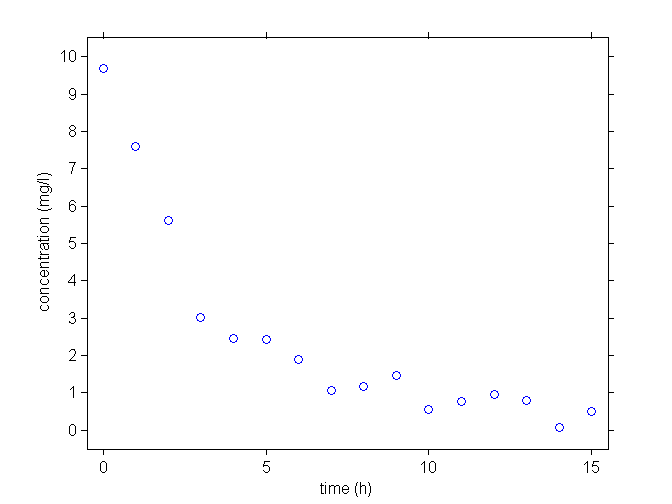The individual approach
An example of continuous data from a single individual
A model for continuous data:
\begin{eqnarray*}
y_{j} &=& f(t_j ; \psi) + \varepsilon_j \quad ; \quad 1\leq j \leq n \\
&=& f(t_j ; \psi) + g(t_j ; \psi)\teps_j
\end{eqnarray*}
- $f$ : { structural model}
- $\psi=(\psi_1, \psi_2, \ldots, \psi_d)$ : vector of parameters
- $(t_1,t_2,\ldots , t_n)$ : observation times
- $(\varepsilon_j, \varepsilon_2, \ldots, \varepsilon_n)$ : residual errors ($\esp{\varepsilon_j} =0$)
- $g$ : { residual error model}
- $(\teps_1, \teps_2, \ldots, \teps_n)$ : normalized residual errors ($\var{\teps_j} =1$)
Some tasks in the context of modelling, {\i.e.} when a vector of observations $(y_j)$ is available:
- Simulate a vector of observations $(y_j)$ for a given model and a given parameter $\psi$,
- Estimate the vector of parameters $\psi$ for a given model,
- Select the structural model $f$
- Select the residual error model $g$
- Assess/validate the selected model
Maximum likelihood estimation of the parameters:
\begin{equation}
'"`UNIQ-MathJax19-QINU`"' maximizes '"`UNIQ-MathJax20-QINU`"' \teps_i \sim_{i.i.d} {\cal N}(0,1)'"`UNIQ-MathJax21-QINU`"'y_i'"`UNIQ-MathJax22-QINU`"'(y_1, y_2, \ldots y_n)'"`UNIQ-MathJax23-QINU`"'\times'"`UNIQ-MathJax24-QINU`"'y_{j} = f(t_j ; \phi) + a \, \teps_j'"`UNIQ-MathJax25-QINU`"'g=a+b*f'"`UNIQ-MathJax26-QINU`"'g=a'"`UNIQ-MathJax27-QINU`"'g=b\, f'"`UNIQ-MathJax28-QINU`"'g=a+b f'"`UNIQ-MathJax29-QINU`"'u(y_j)'"`UNIQ-MathJax30-QINU`"'y_j'"`UNIQ-MathJax31-QINU`"'g=a+b*f'"`UNIQ-MathJax32-QINU`"'\log(y)=\log(f) + a\, \teps$
\end{tabbing}
